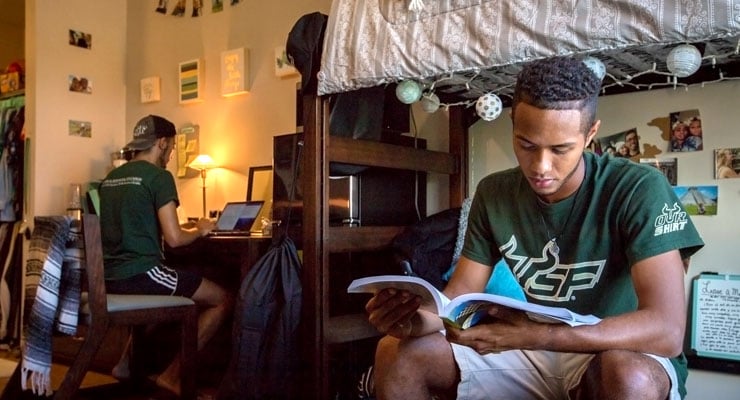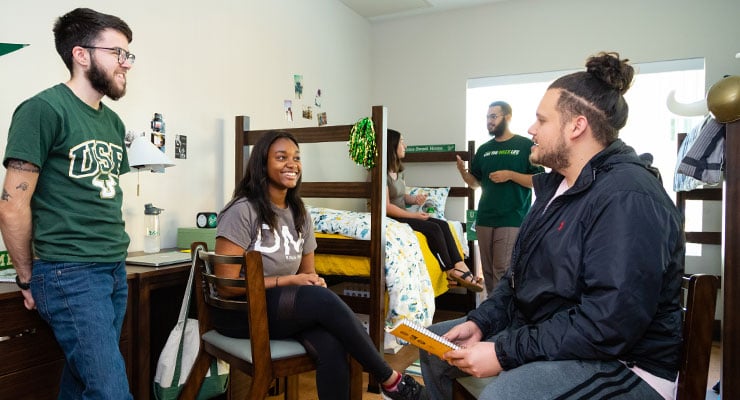
If you’re not sure how to choose your room style at college, you’re not alone. With a wide and overwhelming range of student housing at most colleges, it can get confusing for incoming students and their families. But if you use our tips as a guide — and pay attention to the do’s and don’ts of selecting a residence hall — you’ll set yourself up for an excellent freshman-year living experience on campus. To figure out how to choose your room style at college, start by understanding the pros and cons of your student housing options.
Get to Know Typical Room Styles
Every college is different, but most campuses offer four standard room styles. Each of these styles may be housed in a traditional residence hall—meaning an old-school dorm, often with a communal bathroom down the hall—or in an apartment-style building, often with private bedrooms and bathrooms. It just depends on the amenities the school offers.
- The Single: Private room for one student, typically 10x12
- The Double: Shared room for two students, typically 11x20
- The Triple: Shared room for three students, typically the same size as a double. USF does not offer this room arrangement.
- Apartment Style: Shared suite for four students, often with private or double bedrooms and a shared living space, usually with semi-private bathrooms; dimensions vary
Which Room Style Should You Choose?
The Single
The single offers peace, quiet, and privacy, no sharing of wall space, awkward silences, or the minor annoyances roommates must learn to navigate. The single is the unicorn of campus housing, but going solo can have its drawbacks.
Pros: A single is great for you if you put your study habits above hanging out; if you have health concerns; if you want to be near the action (just not constantly immersed in it); if you already have friends on campus; and if you keep unusual hours.
Cons: Singles are small, often reserved for upperclassmen, in high demand, and pricier than shared rooms.
Do this: Buddy up with one or two people living in your building who can let you in if you forget your keycard or make a coffee run with you. And leave your door open every now and then to make small talk with students passing by on the way to their rooms.
Don’t do this: Expect living solo to be perfect. In some ways it can be more challenging because you won’t have the built-in social system of suitemates and you’ll have to do all the cleaning and snack purchases on your own.
Top tip if you’re considering a single: To avoid feeling isolated and lonesome, go out of your way to make friends by joining in, signing up, and taking part in campus activities, especially if you’re an introvert inclined to hide away in your room. Make it a priority to find your tribe.
The Double
The double offers a little bit of togetherness, but not too much. It's ideal for students seeking the traditional dorm experience and the comfort of having a live-in acquaintance.
Pros: A double is great for you if you are a little shy and need a nudge to get in the mix (a roommate can instantly widen your social circle); if you are accustomed to sharing your room with a sibling; and if you have the gift of compromise and don’t mind splitting your bag of chips.
Cons: Doubles can be less than ideal if you put a premium on your personal space; if you brood, boil, or resent rather than resolve conflict amicably and quickly; if you struggle to warm up to strangers; and if you expect a stylish living space. Depending on the college, the double may be a bare-bones bunk space that is possibly in the same building your great Uncle George lived in when he was a freshman. However, this isn't always the case. The Village at USF, our newest residential community, is comprised of mostly double (traditional and suite) rooms.
Do this: Connect with your roommate on social media before move-in day. Getting to know a little about each other ahead of time eliminates some of the awkwardness before negotiating who gets the bed by the window.
Don’t do this: Expect to be best friends with your roommate. The goal is learning to live together while making freshman year rewarding and fun. It can happen naturally, but requiring a double to result in a lifelong friendship is just too heavy a burden for a two-semester living arrangement.
Top tip if you’re considering a double: Think twice before rooming with your best friend from high school. Although it is comforting and exciting to embark on the college journey together, becoming roomies can keep you from expanding your social circle and trying new things. Instead, submit your housing request form at the same time as your friend, selecting the same building, but not requesting each other for a roommate assignment. That gives you better odds of keeping connected, but not perpetually trapped in a rerun of high school.

The Triple
The triple offers the trickiest arrangement because it is often the result of overbooking due to a campus housing shortage. Usually foisted on freshmen by squeezing three students into a room built for two, space in a triple is tight. Some colleges do offer suites designed for triples.
Note: USF does not offer this room arrangement.
Pros: A triple might be great for you if you are a social butterfly; if you prefer studying in a group; and if you’re pretty chill about your personal space and comfort requirements. Plus, a triple is the least expensive room option and frequently is assigned to the older residence halls in the heart of campus, walkable to everything.
Cons: Because it is meant to house only two students, a triple is cramped, requiring ingenious furniture arrangement and diplomacy.
Do this: Pack light. No need to stuff lamps or storage containers in your space if your roommates already hauled in the extras. Your closet will be small, so keep your wardrobe limited to the season and rotate at semester breaks and holidays.
Don’t do this: Suffer in discomfort. Talk with your resident assistant if your overcrowded living situation is unhealthy or is negatively affecting your grades. As the semester proceeds, housing does become available, so a move to another room could be possible.
Top tip if you’re considering a triple: Invest in quality noise-canceling headphones so you can game, stream, or listen to music without bothering your roommates (and vice versa).
Apartment Style
Apartment style, also known as the quad, can be the ultimate in on-campus housing when it is housed in a suite with a small common living room. This section focuses on apartment-style quads, with private or two-person bedrooms, and private or semi-private bathrooms.
Pros: An apartment-style quad is great for you if you want the best of both worlds — the privacy of an apartment, but the security and high-energy vibe of living on campus. Fewer people sharing your bathroom is always a good thing.
Cons: Apartment style can be more expensive than a double. The apartment style can counterintuitively add a sense of isolation if you close yourself off from your suitemates in your private bedroom. You and your roommates may be responsible for cleaning a shared bathroom (and your mates may not share your enthusiasm for bleach spray).
Do this: Create a roommate group to be assigned to the suite with a friend from high school but leave the other two spots open to randomly assigned roommates. Sharing a suite with strangers will instantly add to your established social squad and boost your friend-making skills.
Don’t do this: Feel obligated to do every activity as a foursome. Avoid making anyone feel like the odd one out, but remember that becoming an exclusive clique of four will do your social life zero favors as well.
Top tip if you’re considering apartment style: Agree to clear and fair boundaries for your common areas. You should agree on touchy topics like overnight guests, which foods are to be shared, who will do which chores when, appropriate noise levels, etc. Planning first diminishes drama later.

Take a Tour Before You Decide
If you’re still not sure which room style is best at your school of choice, visit campus in person or take a virtual tour of the residence halls. Even if your college website doesn’t host a video of the residence hall you’re interested in, it is more than likely you can find a student’s personal video of their room (and honest comments) uploaded to the web. Like many colleges, USF walks you through the application process.
One Last (Important) Suggestion
Make your housing decisions early because on-campus rooms do reach capacity.
If you are considering USF or you are already admitted, your main-campus housing choices include traditional, suite, and apartment-style options, as well as living learning communities where students with similar interests or majors live together. The USF admission team is ready to answer your housing questions, so please contact us online or by phone at 813-974-3350.



